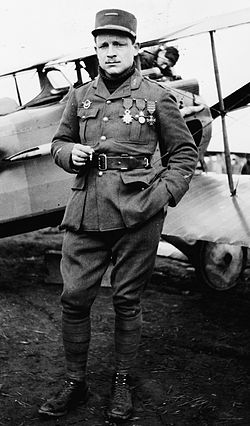Monuments
The Lafayette Escadrille Heroes Memorial
Raoul Lufbery Memorial Plaque -Lafayette Escadrille
French-US Aviation Plaque- WW1
Rouze Main Camp/Airfield Information Sign, WW1
Rauol Lufbery Plaque - Chamalières

Born 14 March 1885 in Chamalières, France. Enlisted US Army 1907-09, service in the Phillipines. Enlisted in the French Foreign Legion and started pilot training in 1914. Commissioned US Army Air Service 1917. Lept to his death from his burning plane on 19 May 1918 near Maron, France. 17 confirmed victories.
From the National Aviation Hall of Fame:
L
ufbery, Gervais Raoul
Military Combat/Military Strategist
Enshrined 1998
1886-1918
The mechanical skills that Lufbery learned while in the company of Marc Pourpe paid dividends as his reputation as one of France’s premier combat pilots grew. His large list of victories could be attributed to his well maintained plane. A fellow pilot once remarked, “Lufbery was a wonderful mechanic and his plane was always the best in the Escadrille. Anyone would rather have a secondhand Lufbery machine than a new one, anytime.”
In 1914 Lufbery and Marc Pourpe went to France to join the war. Pourpe pulled some strings to make Lufbery his personal mechanic. The death of Pourpe spurred Lufbery to attain his wings.
In 1916 he joined the Lafayette Escadrille, a unit composed of American volunteers, and within three months he had five official kills. Lufbery thus became America’s first ace. His official kill record is 17, but unofficially it is much higher.
In 1918 he became combat instructor of the American “Hat in the Ring” 94th Pursuit Squadron. The same squadron as Rickenbacker.
He developed fighter tactics such as the Lufbery Show, also known as the Lufbery Circle, in which the flyers formed a circle with each plane protecting the plane in front.
On May 19th, 1918 he was killed while attacking a heavily armed Albatross bomber.
Biography:
On May 19th, 1918, Lufbery flew one last time. Observing from the ground an inexperienced fellow American pilot fighting a German reconnaissance plane above the 94th’s field, Lufbery rushed to another pilot’s Nieuport (his own was out of commission). With no time to check the machine gun, Lufbery sped off to the attack. Observers noted that Lufbery attacked the heavily armored Albatross bomber, and then seemed to retreat in order to clear a jammed gun. His cockpit burst into flames and he either jumped or fell from a high altitude. His broken body was recovered from a peasant woman’s yard near Nancy, France and buried the following day with full military honors. After the war, a monument to the Lafayette Escadrille was erected in Paris. The monument was for the memory of those men who served and died, helping others in their desperate time of need. Lufbery commanded great respect as a pilot and an instructor, and many have cited him for his courage and calm in dangerous situations. Lufbery also won great respect for his accomplishments and for his willingness to explore, learn, and experience. To the Americans he was an “Ace of Aces.” To many individuals, as well as nations, he is remembered, not just as a warrior, but as a teacher and a friend. For the courage and valor he personally demonstrated and which he instilled in others, Gervais Raoul Lufbery joins the ranks of America’s Aces. He is enshrined with highest honor into the National Aviation Hall of Fame.
